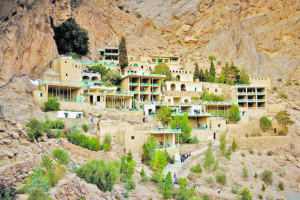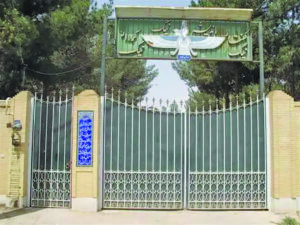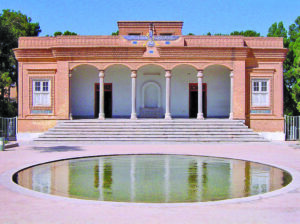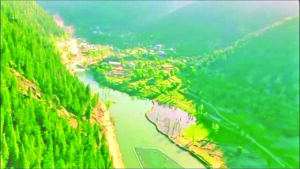The narrow plain of Yezd or Yazd is surrounded by mountains and deserts. The climate is harsh with extremely dry and hot summers and searingly cold winters. Since the rainfall is scanty, the plain is partly desert — in some places glittering white with salt, in others, covered by shifting, engulfing sands.
Kerman and Fars lie to the south, while Esfahan (or Isfahan) is to the West of Yezd. The highest mountain in this province is Shirkuh (Milky Mountain, named due to the perpetual snow-cover, even during summer) which is 4,055 metres high!
Marco Polo was the first tourist to visit Yezd in 1272 A.D. and found it to be a habitable city with ‘intelligent, brave and talented people’.
Zoroastrian Innovations: To beat the summer heat, the residents of Yezd have badgirs, or wind-towers, an ancient method of air-conditioning. The construction of badgirs and qanats (or the long underground tunnels which bring the cool water of the melted snow from the mountains, which also feed underground water tables to the parched desert regions, without evaporation), is a skill known only to a few families of Yezd and is reportedly a Zoroastrian invention. In the days of persecution, Zoroastrians used to go from one village to another through these qanats.
In her engrossing book, A Persian Stronghold of Zoroastrianism, Prof. Mary Boyce states, “… the Arab conquest of Iran in the 7th century A D was not achieved by a few great battles, but took more than a generation to accomplish: and that, although Islam was established thereby as the state religion, it needed some 300 years, or 9 generations, for it to become the dominant faith throughout the land… but late in the ninth century the tide began to ebb swiftly for the Zoroastrians… the only two places where Zoroastrians succeeded in maintaining themselves in any numbers were in and around Yazd and Kerman”.
The villages of Yezd have a mystique of their own. The beauty and charm of these villages lie in their simplicity, spontaneity, and total harmony with the natural surroundings. The architecture of the villages is standard — mud houses appearing plain and simple from the outside, but generally well-furnished from within. Each house generally has a courtyard — some even with fish ponds and pomegranate trees. The rooms have natural cooling systems and openings in the roof for natural light to filter in.
The Zoroastrian villagers are a simple, warm and friendly. They love meeting fellow Zoroastrians who come as tourists or pilgrims and their hospitality and graciousness is legendary. Even the poorest Zoroastrian family would not allow a visitor to leave without the mandatory cup of tea, sweets, or fruits.
Zoroastrian Mountain Shrines:
The mountain shrines are known as Pir (Persian for old/ancient). These shrines consist essentially of sacred rocks in high and lonely places. According to folklore, after the defeat of Yazdagird III, the last monarch of Sasanian Iran, at the hands of the Arab invaders, his family not only had to flee from the palace, but were also separated and had to roam about in the wilderness. The invaders were in hot pursuit of Yazdagird’s wife and daughters. It is believed that when everything seemed lost, the Queen and princesses prayed to Ahura Mazda for help, whereupon the mountains opened and took them in.
For some, these stories may seem far-fetched and difficult to believe. But for Zoroastrians in Iran, the Pirs and the stories wrapped around them are an article of faith. If you ask them if they really believe in these stories, they shoot back: “Do you believe in Ahura Mazda? Do you believe He is Good, All-Knowing, and Powerful? Do you believe that He created this entire universe which also include these mountains? If you do, then what makes you think Ahura Mazda cannot do something as simple as opening a mountain to protect a sincere devotee and save her from the clutches of evil-doers?” This simple argument leaves any doubting pilgrim speechless.
Prof. Mary Boyce in her book, A Persian Stronghold of Zoroastrianism, writes, “These sanctuaries were very dear to the Zoroastrians, so much so that one explanation which they gave for their seemingly miraculous survival as a community was that they had been spared ‘for the sake of those in the hills’, that is, so that they might continue to worship at these remote places, and to maintain the rites which were proper to them.”
“The five sanctuaries”, continues Boyce, “and one other in the plain near the city of Yezd, were in communal trust. Each village looked after the shrines in its own fields and lanes, but all joined together to care for these six. To visit any of them on any occasion was an act of much merit, but the merit was greatest when one joined in the yearly pilgrimage at the time appointed. Each pilgrimage lasted officially for five days, like each of the major festivals.”
 Pir-e-Sabz:
Pir-e-Sabz:
Pir-e-Sabz, literally meaning the green old shrine, is among the most famous, and is situated on the north eastern side of the Yezdi plain. Not a bird or animal can be seen for miles. Not a blade of grass grows for miles. And, then, suddenly, out of nowhere, a patch of green on the mountain — a mountain oasis more popularly known as Chak-Chak or ‘Pir-e-Sabz’.
Here, the sacred rock (where the princess Hayat Banu is believed to have been taken in) is high up on the steep face of a great limestone mountain, besides a pool of water. This pool is fed by a spring that flows, seemingly miraculously, out of the bare cliff above. The course of the trickling water is green with maidenhair fern (believed to be the hair of the princess) and the huge old plain tree which shades the sacred rock is believed to have grown from a stick on which the princess leant and which she thrust into the ground before vanishing. This tree is said to catch fire and renew itself phoenix-like, every thousand years. By the pool, there is also a giant willow which age has bent right over so that trunk and branches spread across the water and down to the rocks beyond.
From the foot of the mountain, one can see a honeycomb of terraces and little buildings clinging like a Tibetan monastery to the rock face. The climb all the way to the uppermost bungli is steep and can take the wind out of most of us. What refreshes immediately, however, is a drink of the water that trickles out of the mountain. The locals call it aab-e-Hayat, or the water of life, and it is as sacred to them as the water of the river Ganga is to the Hindus.
The view from the uppermost terrace at Pir-e-Sabz is stupendous and if one is sensitive enough, one can visualise how the hapless princess must have come running to this mountain. How she must have prayed for protection and aid. And even if the mountain did not really open and take her in, Ahura Mazda in His Wisdom and Goodness, must have certainly protected her in some way or other in the wilderness. Pir-e-Sabz is also symbolic of the victory of good over evil. No wonder, when the Iranian Zoroastrians return from their annual pilgrimage in the mountains, they come back stronger in their beliefs and conviction in their religion.
Banu Pars
According to legend, Yazdegird’s daughter, Banu-Pars, fleeing from invading Arabs, came alone to the head of the Yezdi plain. Tired and thirsty, she requested a peasant for something to drink. He milked his cow for her but, just as the bowl was full, the animal kicked it from his hands. Since the Arabs were drawing close, she had to go on with a parched throat. Turning towards the mountains, she stumbled up a dry river-bed. She begged the ‘Stone of the Curse’ to open and take her in, but it remained unmoved. She went on further into the mountain and cried out to Ahura Mazda for help and He opened the rock before her and she hastened in, never to be seen again. However, a piece of her dress was caught, it is said, by the closing stone. Iranians claim that their grandparents had seen the fragment of cloth, pieces of which were cut and taken away by pilgrims over years, as a sacred relic. Today, there is no trace of the cloth in the natural cleft in the sacred rock. Once again, at this shrine, we light a fire and offer worship.
Childless women are known to have their wishes fulfilled after praying and tying the symbolic ribbon at this Pir.
 Set-e-Pir
Set-e-Pir
Set-e-Pir, is situated east of Yezd. This shrine marks the place where Yazdagird’s queen, the mother of the princesses, Banu-Pars and Hayat-Banu, herself fleeing from the Arabs, sank exhausted and was taken living into the rock, together with her two attendants. Set-e-Pir is, therefore, regarded as the mother of the other five great Pirs.
There is also a fascinating account of how the shrine came to be built. A Zoroastrian from Yezd was imprisoned and sentenced to death for entering the holy city of Meshed. In those days, no non-Muslim could enter this city of Meshed, just as even today no non-Muslim can enter the holy city of Mecca. In prison, the Zoroastrian had a dream in which he was told the story of Set-e-Pir and asked to prepare himself to make the story known to others and build a shrine on the spot he would find himself the next morning. Indeed, the next morning, the Zoroastrian found himself not in his prison cell, but in Yezd. It appears, on verification it was found that prison records in Meshed did indicate a Zoroastrian having escaped from  prison.
prison.
Shrine of Nauraki
Nareke or Nauraki — is one of the six major Pirs and considered to be holy by Iranian Zoroastrians. Nareke is situated at the foot of a mountain of the same name in the valley of Gaigun. The daughter of the Zoroastrian Governor of Yezd is believed to have miraculously disappeared somewhere in this mountain.
Pir-e-Hrist
The shrine rests on the crest of a ridge which rises from the shingle of a plain, set in a ring of mountains. A Royal maid (Khanum Morvarid) serving the royal household, fleeing with a child of the royal family, is believed to have been taken in by the mountain here along with child from the Royal family.
Norestan
Norestan is ensconced in a remote part of Yezd. The climb up the dry riverbed is difficult. The shrine is surrounded by mountains and is lush and colourful with a variety of fruit-bearing trees and other flora and fauna. This shrine is dedicated to the son of Yazdagird, named Ardishir. The incense burner at this shrine is in the shape of a crown (Ardishir’s crown).
- Is Adoption Legal Among Parsis In India? - 2 November2024
- Celebrate Diwali With The Light Of Goodness - 26 October2024
- Attaining Khordad Or Wholeness In Life - 19 October2024
